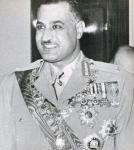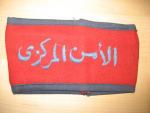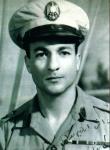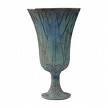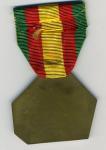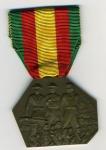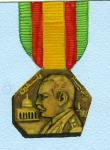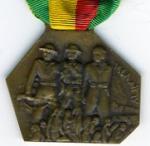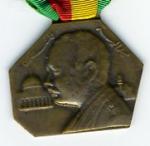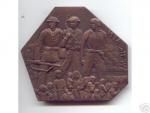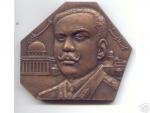
ChrisW
Patron-
Posts
303 -
Joined
-
Last visited
Content Type
Profiles
Forums
Blogs
Gallery
Events
Store
Everything posted by ChrisW
-
This is the regular Police. Turkish Military police insignia generally say "Askeri Inzibat." Cheers, Chris
-
Finally, one of my favorite pictures of Nasser, during his (1955?) visit to Yugoslavia -- one of the last times he wore his military uniform, and the only photo I know of him wearing full-size medals. Among others, he wears the post-revolution "flipped" Palestine medal.
-
Leigh, You'll be pleased to know that, 29 years on, the Egyptian police still excel at hopping off trucks, with helmets and AKs, in vast numbers! Cheers, Chris
-
-
-
And a closeup of the lotus blossom on Mohieddin's ribbon. (Oh, photo credit: archive photo reprinted in Akher Sa'a magazine, March 7, 2001.)
-
Here's Lt. Col. Zakaria Mohieddin wearing the lotus blossom on his Palestine Medal ribbon, in a circa 1952-1954 photo. (Mohieddin was one of the Free Officers who led the 1952 revolution.)
-
The second known device for this medal is a brass stylized lotus blossom, a common symbol in Ancient Egypt, worn on the ribbon. This may represent the bar previously described, but that's just a guess. I'm not going to try to sketch the lotus blossom design, but it roughly looks like this (image stolen from a Google search).
-
-
-
There are two known devices/appurtenances to the Egyptian Palestine Medal. The first is a bar, reading in Arabic "Waqa'a Filistin" which could be translated as "Palestine battles." This may indicate that the recipient saw combat. However, this bar is scarce -- I've only seen it on the medal in my possession and one at Cairo's Military Museum. Soldiers who saw combat in the war haven't been seen wearing this bar.
-
-
Following the overthrow of King Farouq in 1952, themedal was modified to remove the king’s image. The reverse of the medal became the obverse, and the former obverse with the king's image was now blank. It seems likely that not all medals were restruck with a blank reverse and reissued to the original recipients, so that recipients simply flipped their existing medals around. Here's the obverse of the post-1952 version.
-
-
One of the favorite pieces in my collection, a watercolor of the medal done by the designer and manufacturer Tawfiq Bichay.
-
-
This is an unusual variation of the King Farouq version of the medal, which I recently acquired. It's cast rather than struck, and is rather crude. The ribbon is also a little too new and fresh looking. This makes me think it might be a fake. But the market for Egyptian medals is so small, and the prices so low, that I don't see the point of faking these.
-
-
The final design of the medal as issued modified King Farouq, so that he was presented in profile, facing left. Behind him on the left is Jerusalem's Al Aqsa mosque, and on the right is another mosque, which might be Cairo's Al Azhar. Above are the Arabic words "miidaaliyya filistin" or "Medal of Palestine."
-
Here's the reverse of the trial design, which was unchanged for the final design. It depicts threeEgyptian soldiers marching towards the right, with their heads turned to theleft. From left to right, they area Navy sailor wearing a helmet and carrying a Lee Enfield Mk III rifle, an Armysoldier wearing battledress and helmet with a slung rifle, and an Air Forcepilot wearing a flight suit and flying helmet, with holstered pistol on hiship. Underneath them are variousPalestinian refugees fleeing burning and destroyed buildings in thebackground. On the right edge ofthe medal is the Islamic date 1367, and the corresponding Christian date 1948,both in Arabic.
-
Going through my collection and files the other day, I realized I had quite a bit of material on Egypt's Palestine War campaign medal, so thought I might try to put it all together here. Hope it's of some interest. The Palestine Medal was the first modern Egyptiancampaign medal, for service in the 1948-1949 Arab-Israeli war (aka Palestine War, War of Israeli Independence). For collectors this medal is one of the most commonly-seen andwidely-available modern Egyptian medals. (Also, interestingly, it is usually found with the ribbon intact, unlikemany other modern Egyptian medals.) This availability leads me to conclude that it was widely issued toEgyptian military personnel (again, unlike most other modern Egyptian service medals, which seem to mostly exist in ribbon form.) The exact criteria are unknown – for example, whatperiod of time and geographic area qualified, or whether Egyptian civilianssuch as the Muslim Brotherhood volunteers were eligible. The meaning of the distinctive shape of the medalis unknown. It is an irregularseven-sided shape, which may represent a stylized outline of the Old City ofJerusalem. Dimensions are 45mm at the widest point, and 36mmat the tallest (not counting the suspension.) The ribbon is 37mm wide, with equal stripes ofgreen, red, yellow, red, and green. The meaning of the ribbon colors are also unknown. The colors of the Egyptian flag at thetime was green and white. ThePalestinian national flag is red, white, black, and green. The first group of images here are from what looks like a trial design for the medal, by the designer Tawfiq Bichay. These images are taken from an internet auctionwebsite, back in 2004. If I recall, this piece wasconsiderably larger than the actual medal, more like a clay or bronze model rather than the actual medal itself. The obverse features an obliqueview of King Farouq, though a rather unflattering one, with heavily-lidded eyesand rather comical mustache. (Ican see why King Farouq may have asked the designer to go back to the drawingboard.) Otherwise it's identical to the design used on the actual medal itself.
-
Doc, Can't help with the medal itself, but a more likely translation of taqdir is "appreciation." Cheers, Chris
-
Queen introduces new military medal
ChrisW replied to Bob's topic in Great Britain: Orders, Gallantry, Campaign Medals
The most detailed article I've seen is on the MOD website: http://www.mod.uk/DefenceInternet/DefenceN...allenTroops.htm -
The Reich in Iraq?
ChrisW replied to The Monkey God's topic in Germany: Third Reich: State, Civil, NSDAP Awards & Decorations
Well, Germany did have some advisors/pilots in Iraq in 1941-42 (I think), but this seems like it's more likely a modern-day imitation of the cuff titles intended as souvenirs for international troops serving in Iraq right now. During Operation Desert Shield/Desert Storm, the US Marine Corps locally used a globe-and-anchor on palm tree insignia that was reminiscent of the Afrika Korps insignia. This may be a similar influence from the Wehrmacht. -
A book on Egyptian civil court uniforms??? I would be extremely interested in any further details, if available. There are a few Egyptian-published books (many in English) that feature photos of uniforms of royalty and civil servants, but as far as I know none specifically on the uniforms themselves. I've spent quite a lot of time traveling in Egypt and rooting around in bookstores, with limited success. There are of course a number of good bookstores and publishers in Cairo, where you can occasionally find surprises. The American University in Cairo Press publishes a number of illustrated books on 19th and early 20th century Egypt (with some incidental photos of uniforms in them), they're one of the few Egyptian bookstores/publishers with a web presence http://www.aucpress.com/t-aucbookstores.aspx though their website is often extremely shaky, and I'd be reluctant to order anything directly from them -- most of their books are available on Amazon and elsewhere. Chris


